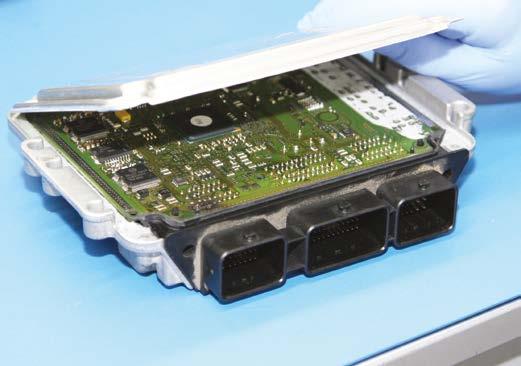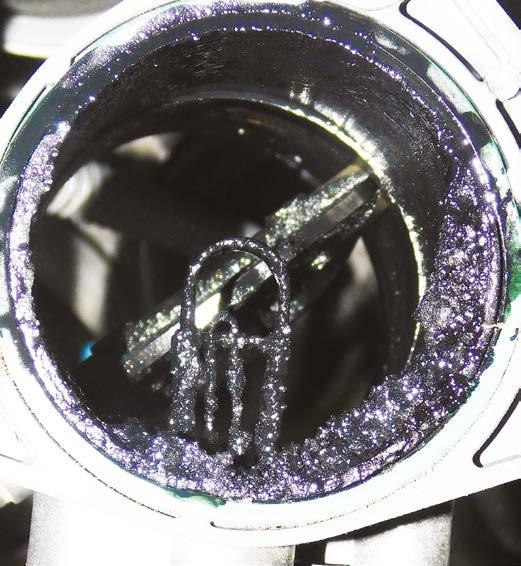
5 minute read
Ignition
Consider how dirt affects sensor output and how you can avoid fault codes leading you by the nose in your diagnosis procedures.
Oxygen (O2/Lambda) sensor replacement tips
Such sensors are vehicle specific, which emphasises why a replacement part must share the same specifications as that fitted at the factory.
Due to their location, constant contact with corrosive gases and the extremely high-temperature exposure, corrosion tends to make removal extremely tricky. Therefore, invest in special tools, such as a tube spanner. While this can prevent damage to the sensor, it can also reduce the risk of personal injury.
Once you have removed the old sensor, check that the threads in the exhaust pipe are clean and serviceable. NGK told AT that all sensors, sold under its NTK brand, have an anti-seize grease applied to its threads but warns that alternative greases can damage the sensor.
Tighten the sensor to the recommended torque; overtightening can damage the sensor body, as well as the threads. The torque is specified to ensure not only a good seal but also an adequate electrical earth, where needed. Check the multiplug for physical damage and corrosion too, prior to connecting-up the main loom and routing the wiring in such a way that it cannot be damaged by heat.

Ignition: Avoiding trouble by keeping clean
While contemplating the meaning of life, Rob Marshall finds that dirt is a significant factor that influences ignition system longevity but he also finds that technician attitudes also play vital roles.
Like all parts of a motorcar, engine management sensors have a finite life. While they can fail suddenly, old parts on old and high mileage cars are likely to be past their best. While the rate of deterioration may not be sufficient to trigger an Engine Management Light (EML), they might not be working at their absolute optimum. Working on this basis, if the customer complains of erratic running, or a noticeable fall in fuel efficiency, then further diagnosis into sensor output would be a good idea before annoying the customer and 'firing the parts cannon', to coin a Dilloneon phrase.
A dirty state of mind
Contamination is a major threat to sensor accuracy. With oil residue and exhaust gases passing through the inlet manifold, it is unsurprising that turbo boost and air temperature sensors, for example, can become clogged, which might send inaccurate readings back to the engine management system.
While cleaning can restore some sensors, consider whether the labour charges involved eclipse those of replacing the part. Should you decide to clean a sensor, research how you can do it and which product to use. For example, while hot wire MAF sensors tend to have their own built-in cleaning feature
ECU damage can occur from low-grade sensors and ignition components. Thankfully, many types can be remanufactured by mail-order companies, such as ACtronics, because it is a specialist task.

to vapourise deposits (working like a self-cleaning oven), they benefit from periodic cleaning to remove gums and bakedon oil with a suitable solvent. However, certain sprays leave a to moisture, vibration and heat. Take oxygen sensors as an example, where low-grade examples tend to be more susceptible to contamination, because they tend to lack an effective protectant coating. This is important, because contamination is one of the biggest causes of oxygen sensor failure and their location and harsh working environment make them one of the hardest sensors to replace. Naturally, a faulty sensor can cause the catalytic converter monolith to overheat and melt, due to the excessively rich fuel mixture. The same situation affects ignition coils. Low-quality items may look identical on the outside but, to perform as the car manufacturer intends, they must contain high-quality wires and coatings. Inferior coils tend to make savings in this area and the resultant shoddy wiring and insulation, which can give incomplete combustion. The engine management ECU can
deposit behind as they evaporate, making their use counterproductive.
Servicing considerations
Just as irregular maintenance increases contamination levels throughout the engine; it can also curtail sensor life. Elderly spark plugs with too wide an electrode gap place the ignition coil(s) under greater stress, potentially shortening their lives. Incomplete combustion also places the downstream antipollution systems under greater strain. Naturally, running an engine with a major fault also risks damaging other parts that can set off a chain reaction. For example, as oxygen sensors are poisoned by anti-freeze, running a car with a cylinderhead gasket problem that causes coolant to enter the exhaust system not only risks damaging the sensor but also the catalytic converter.
Choosing parts
from a trustworthy source. Inferior parts are not that easy to spot. Poor quality sensors also tend to be less resistant
rise to the cracks, pinholes and imperfections, can all result in misfires. While the insulation is also strained by voltage jumps from wiring that does not comply with the OE specification, damage can extend far beyond that caused by misfiring and Sensors vary wildly in standards and so strive for OE quality
also be irreparably damaged. It is also worth noting that the ECU can also be harmed by poor quality sensors failing, due to the resultant voltage fluctuation.

There was nothing wrong with this air temperature sensor, other than needing a good clean.
Training opportunities
We are grateful to the technical team at Delphi for its guidance with the preparation for this feature. The company supplies both the OE and aftermarket and told AT that only the packaging differs. Delphi agrees with our philosophy that the key to correct diagnosis is following a thorough fault-finding process and that a fault code is a symptom of a problem, rather than being an absolute instruction. Therefore, technicians must understand the relationship between different components within a vehicle and establish the root cause, using the fault code as a guide. Delphi also highlights its training courses, which are run by master technicians and include both theory and practical sessions. For the latest news, log-on to https://www.delphiautoparts.com/gbr/en/training/training.










